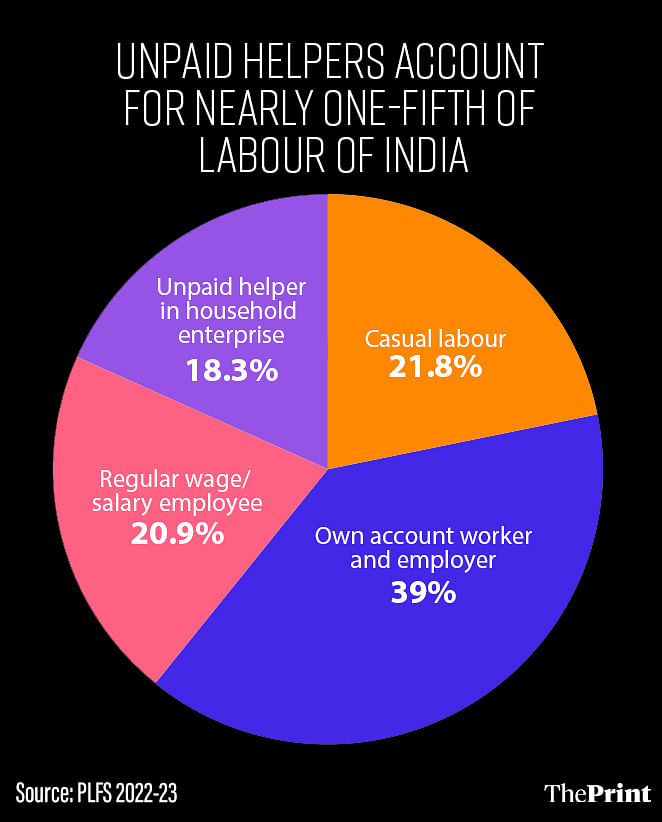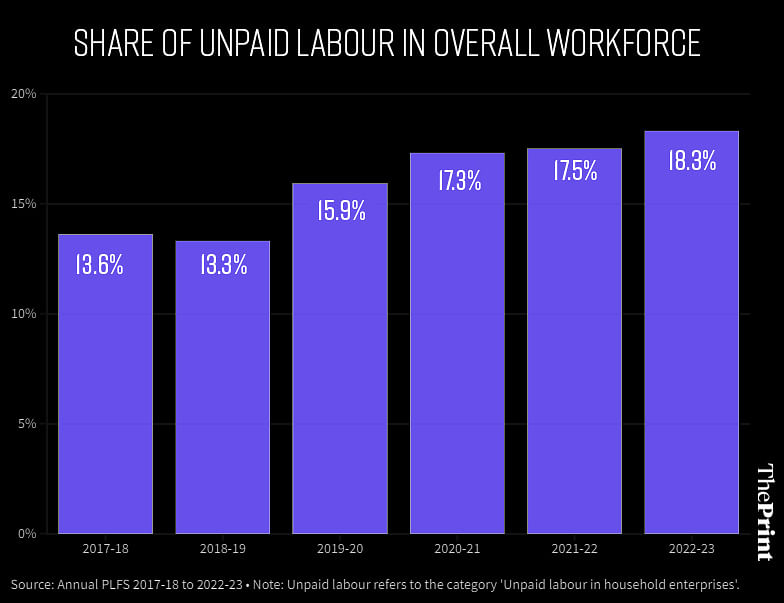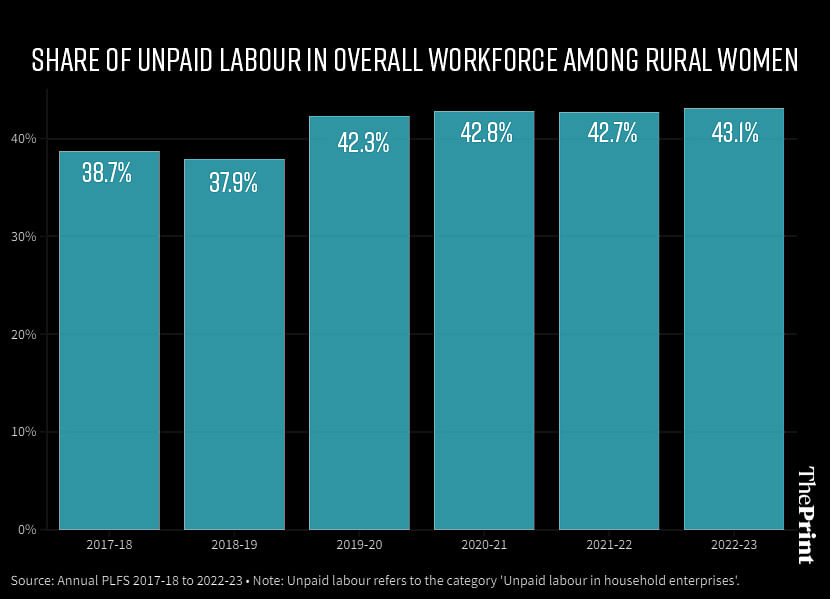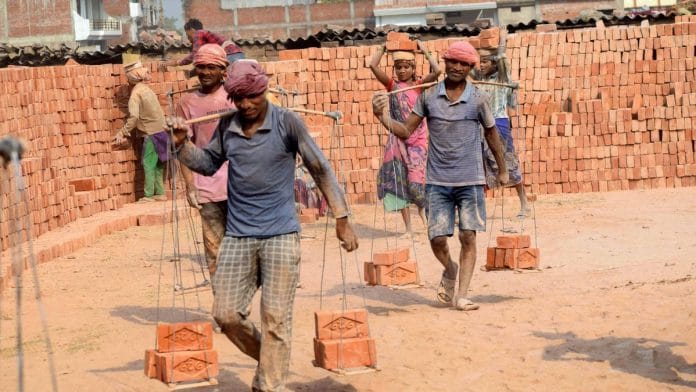New Delhi: Nearly one-fifth of India’s labour force is employed in unpaid work, with the situation even more stark for working women, according to government data. More than 37 percent of women counted as ‘workers’ are doing unpaid work. For rural women, this number is as high as 43 percent.
These findings assume significance in light of Prime Minister Narendra Modi’s statement last Saturday — citing the Reserve Bank of India’s (RBI) data — that his government had created 8 crore jobs “in the past 3-4 years”.
According to economists and statisticians, the concern with unpaid work, or ‘unpaid helper in household enterprise’, which it is officially referred to as, is not as much about the fact that the income is not going to the individual — since it still goes to the overall household.
Rather, the more significant concern is that this kind of work is making up an increasing share in the labour force participation rate, providing a possibly misleading picture of employment in the country.

One estimate says that India’s labour force participation rate, at 37.3 percent, could have been overestimated by as much as 7 percentage points due to the inclusion of unpaid labour in the calculations.
The RBI data the prime minister cited is from the central bank’s KLEMS (K-capital, L-labour, E-energy, M-materials, and S-purchased services) database, the latest edition of which it released last Monday. According to the data, employment in the economy increased by 7.8 crore between 2020-21 and 2023-24. The data for 2023-24 is a provisional estimate and does not include a detailed break-up.
While the KLEMS database looks at various surveys and reports by the Ministry of Statistics and Programme Implementation to estimate economic activity, it sources its labour data exclusively from the Periodic Labour Force Survey (PLFS) conducted by the ministry.
“The labour input series is being updated under each round of India KLEMS using available survey data from PLFS only,” the methodological note accompanying the KLEMS database said.
An analysis of the PLFS, therefore, provides insight into the kind of employment being generated in the country, something that has become a matter of political debate since the prime minister’s statement.
“The growth in employment that is being claimed includes unpaid domestic work done by women as employment,” Congress general secretary in-charge communications Jairam Ramesh told ThePrint. “A large part of employment growth is coming from this segment, but these ‘workers’ are unpaid.”
The Congress party had also issued a statement along these lines Monday.
“The RBI has had a fine reputation for independent research but this completely bogus study quoted by the non-biological prime minister has destroyed that tradition,” Ramesh added. “Yet another institution has fallen.”
Also read: Why is Modi govt afraid of its own successes? Banking, stock market, GST hold the answer
The rise of unpaid labour
The latest annual PLFS data available is for the period June 2022 to June 2023. The data categorises workers as self-employed, regular wage/salaried employees, and casual labour. The self-employed category is further subdivided into own-account workers and employers, and unpaid helpers in household enterprises.

The share of unpaid helpers in household enterprises in the overall workforce has risen from 13.6 percent in 2017-18 to 18.3 percent in 2022-23. In rural India, this share has risen from 16.9 percent to 22 percent, over the same period.
According to the PLFS, unpaid helpers in household enterprises are those people “who were engaged in their household enterprises, working full or part time and did not receive any regular salary or wages in return for the work performed”.
“They did not run the household enterprise on their own but assisted the concerned person living in the same household in running the household enterprise,” the report added.
Pronab Sen, chairman of the Standing Committee on Statistics, explained this to ThePrint through the use of an example.
“Suppose a person has a roadside stall, and their son, daughter or wife helps them run that stall. That son, daughter or wife is not getting paid, but is working, and is therefore considered a worker,” he said.
That said, the PLFS’s definition of people in the workforce does not include those engaged in domestic work. So, it is not as if a woman cooking for her family or performing other domestic chores is considered a part of the workforce.
Rural India and the overestimation of employment
According to Sen, the higher levels of unpaid work in rural India is a reflection of the way farmers go about their activities in India.
“This kind of thing happens to a much larger degree in agriculture, where the entire household takes part in the work but does not receive payment for their work,” he said.
The data confirms this. In addition to the higher levels of unpaid household work seen in rural India overall, this phenomenon is particularly stark when looking at the work status of rural women.

According to the PLFS, 43.1 percent of rural working women were engaged in unpaid household work in 2022-23, up from 38.7 percent in 2017-18. In comparison, this proportion was 11 percent for rural males in 2022-23, up from 9.8 percent in 2017-18.
Sen also pointed out that the concern with the rising share of unpaid labour was that this was adding to the labour force participation rate in India, something other economists have also previously highlighted.
“It could be argued that this inclusion of some unpaid workers in total employment may not matter very much, since such workers could be relatively few and stable over time,” economists C.P. Chandrasekhar and Jayati Ghosh wrote in an article published in The Hindu Business Line in January.
“Yet that is not the case: not only are such workers very significant in proportion, especially for women, but also their presence tends to fluctuate over time,” they added.
According to them, if the unpaid component of the work was removed from the calculations, the “true” labour force participation rate would have been 30.5 percent in 2022-23, significantly lower than the 37.3 percent figure provided in the PLFS report.
“Even more disturbing, the employment rates for women are even worse than those suggested by the official data — barely one in ten Indian women is engaged in some economic activity that provides her with an income,” the two economists wrote. “And this ratio has declined over the decade.”
(Edited by Radifah Kabir)






